The Impact of Social Enterprises and Entrepreneurship: An Essay
VerifiedAdded on 2021/05/31
|9
|2265
|90
Essay
AI Summary
This essay delves into the significant roles of social enterprises and entrepreneurship in fostering economic growth, particularly in the face of global economic challenges. It examines the distinctions between traditional entrepreneurship and social entrepreneurship, highlighting their contributions to job creation, revenue generation, and solutions to environmental and social issues. The essay further explores the operational differences between for-profit and non-profit social enterprises, emphasizing their respective business and financial models, including fundraising, government funding, and crowdfunding. It underscores the importance of proper planning and robust financial models for the effective operation of both social enterprises and entrepreneurial ventures, offering insights into how these entities leverage innovation and social value to address societal needs and promote economic development. The essay also touches on the role of organizations like ENACTUS in nurturing young entrepreneurs and driving positive social change.
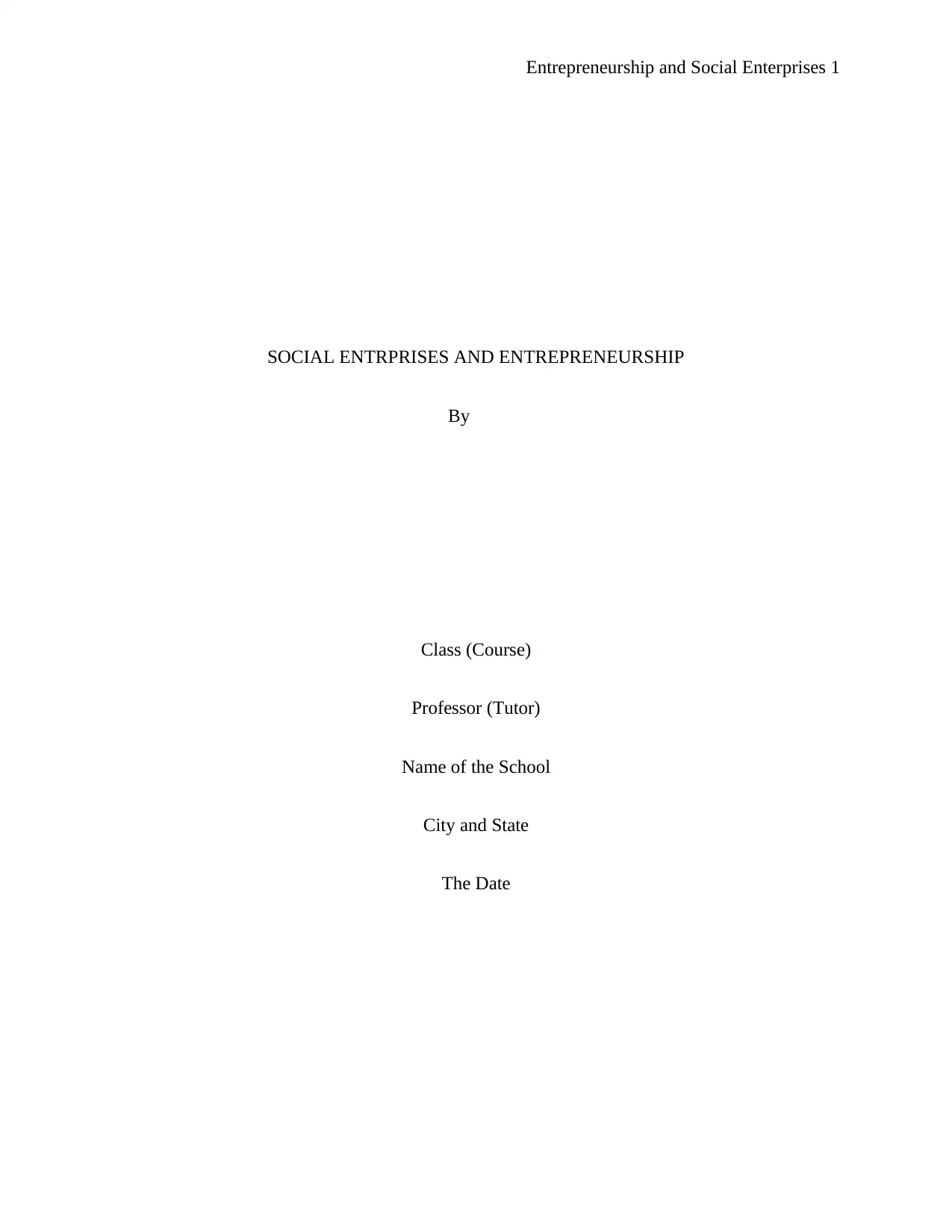
Entrepreneurship and Social Enterprises 1
SOCIAL ENTRPRISES AND ENTREPRENEURSHIP
By
Class (Course)
Professor (Tutor)
Name of the School
City and State
The Date
SOCIAL ENTRPRISES AND ENTREPRENEURSHIP
By
Class (Course)
Professor (Tutor)
Name of the School
City and State
The Date
Paraphrase This Document
Need a fresh take? Get an instant paraphrase of this document with our AI Paraphraser
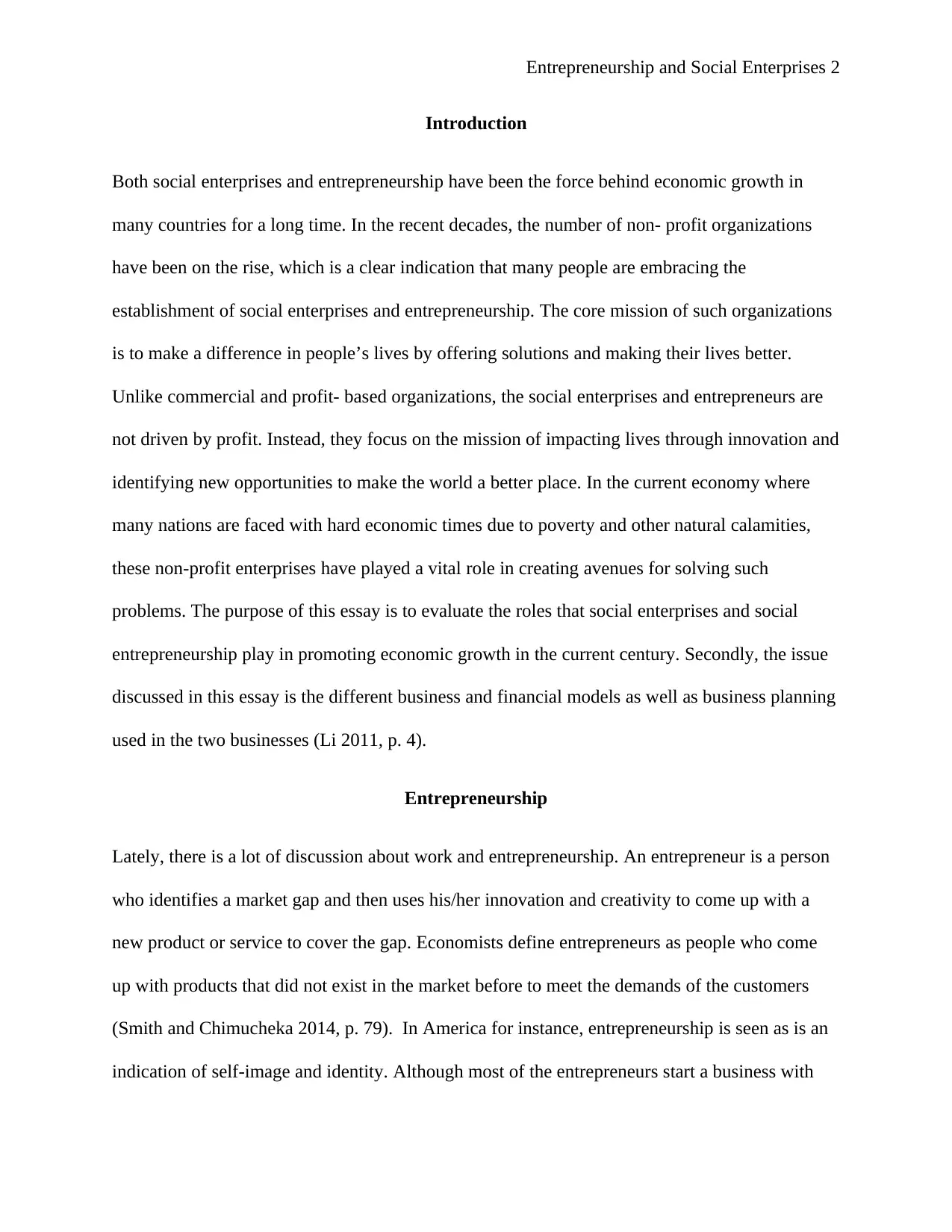
Entrepreneurship and Social Enterprises 2
Introduction
Both social enterprises and entrepreneurship have been the force behind economic growth in
many countries for a long time. In the recent decades, the number of non- profit organizations
have been on the rise, which is a clear indication that many people are embracing the
establishment of social enterprises and entrepreneurship. The core mission of such organizations
is to make a difference in people’s lives by offering solutions and making their lives better.
Unlike commercial and profit- based organizations, the social enterprises and entrepreneurs are
not driven by profit. Instead, they focus on the mission of impacting lives through innovation and
identifying new opportunities to make the world a better place. In the current economy where
many nations are faced with hard economic times due to poverty and other natural calamities,
these non-profit enterprises have played a vital role in creating avenues for solving such
problems. The purpose of this essay is to evaluate the roles that social enterprises and social
entrepreneurship play in promoting economic growth in the current century. Secondly, the issue
discussed in this essay is the different business and financial models as well as business planning
used in the two businesses (Li 2011, p. 4).
Entrepreneurship
Lately, there is a lot of discussion about work and entrepreneurship. An entrepreneur is a person
who identifies a market gap and then uses his/her innovation and creativity to come up with a
new product or service to cover the gap. Economists define entrepreneurs as people who come
up with products that did not exist in the market before to meet the demands of the customers
(Smith and Chimucheka 2014, p. 79). In America for instance, entrepreneurship is seen as is an
indication of self-image and identity. Although most of the entrepreneurs start a business with
Introduction
Both social enterprises and entrepreneurship have been the force behind economic growth in
many countries for a long time. In the recent decades, the number of non- profit organizations
have been on the rise, which is a clear indication that many people are embracing the
establishment of social enterprises and entrepreneurship. The core mission of such organizations
is to make a difference in people’s lives by offering solutions and making their lives better.
Unlike commercial and profit- based organizations, the social enterprises and entrepreneurs are
not driven by profit. Instead, they focus on the mission of impacting lives through innovation and
identifying new opportunities to make the world a better place. In the current economy where
many nations are faced with hard economic times due to poverty and other natural calamities,
these non-profit enterprises have played a vital role in creating avenues for solving such
problems. The purpose of this essay is to evaluate the roles that social enterprises and social
entrepreneurship play in promoting economic growth in the current century. Secondly, the issue
discussed in this essay is the different business and financial models as well as business planning
used in the two businesses (Li 2011, p. 4).
Entrepreneurship
Lately, there is a lot of discussion about work and entrepreneurship. An entrepreneur is a person
who identifies a market gap and then uses his/her innovation and creativity to come up with a
new product or service to cover the gap. Economists define entrepreneurs as people who come
up with products that did not exist in the market before to meet the demands of the customers
(Smith and Chimucheka 2014, p. 79). In America for instance, entrepreneurship is seen as is an
indication of self-image and identity. Although most of the entrepreneurs start a business with
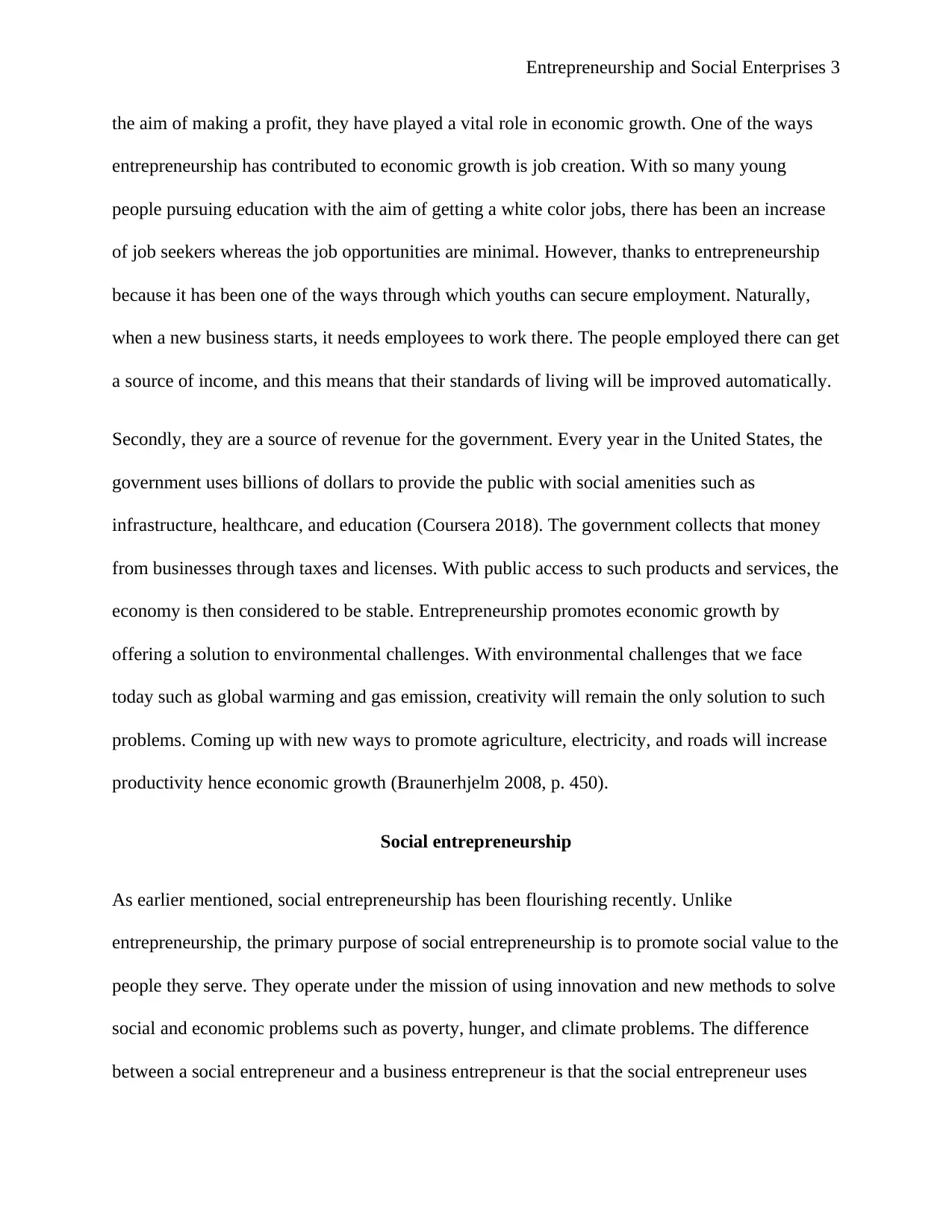
Entrepreneurship and Social Enterprises 3
the aim of making a profit, they have played a vital role in economic growth. One of the ways
entrepreneurship has contributed to economic growth is job creation. With so many young
people pursuing education with the aim of getting a white color jobs, there has been an increase
of job seekers whereas the job opportunities are minimal. However, thanks to entrepreneurship
because it has been one of the ways through which youths can secure employment. Naturally,
when a new business starts, it needs employees to work there. The people employed there can get
a source of income, and this means that their standards of living will be improved automatically.
Secondly, they are a source of revenue for the government. Every year in the United States, the
government uses billions of dollars to provide the public with social amenities such as
infrastructure, healthcare, and education (Coursera 2018). The government collects that money
from businesses through taxes and licenses. With public access to such products and services, the
economy is then considered to be stable. Entrepreneurship promotes economic growth by
offering a solution to environmental challenges. With environmental challenges that we face
today such as global warming and gas emission, creativity will remain the only solution to such
problems. Coming up with new ways to promote agriculture, electricity, and roads will increase
productivity hence economic growth (Braunerhjelm 2008, p. 450).
Social entrepreneurship
As earlier mentioned, social entrepreneurship has been flourishing recently. Unlike
entrepreneurship, the primary purpose of social entrepreneurship is to promote social value to the
people they serve. They operate under the mission of using innovation and new methods to solve
social and economic problems such as poverty, hunger, and climate problems. The difference
between a social entrepreneur and a business entrepreneur is that the social entrepreneur uses
the aim of making a profit, they have played a vital role in economic growth. One of the ways
entrepreneurship has contributed to economic growth is job creation. With so many young
people pursuing education with the aim of getting a white color jobs, there has been an increase
of job seekers whereas the job opportunities are minimal. However, thanks to entrepreneurship
because it has been one of the ways through which youths can secure employment. Naturally,
when a new business starts, it needs employees to work there. The people employed there can get
a source of income, and this means that their standards of living will be improved automatically.
Secondly, they are a source of revenue for the government. Every year in the United States, the
government uses billions of dollars to provide the public with social amenities such as
infrastructure, healthcare, and education (Coursera 2018). The government collects that money
from businesses through taxes and licenses. With public access to such products and services, the
economy is then considered to be stable. Entrepreneurship promotes economic growth by
offering a solution to environmental challenges. With environmental challenges that we face
today such as global warming and gas emission, creativity will remain the only solution to such
problems. Coming up with new ways to promote agriculture, electricity, and roads will increase
productivity hence economic growth (Braunerhjelm 2008, p. 450).
Social entrepreneurship
As earlier mentioned, social entrepreneurship has been flourishing recently. Unlike
entrepreneurship, the primary purpose of social entrepreneurship is to promote social value to the
people they serve. They operate under the mission of using innovation and new methods to solve
social and economic problems such as poverty, hunger, and climate problems. The difference
between a social entrepreneur and a business entrepreneur is that the social entrepreneur uses
⊘ This is a preview!⊘
Do you want full access?
Subscribe today to unlock all pages.

Trusted by 1+ million students worldwide
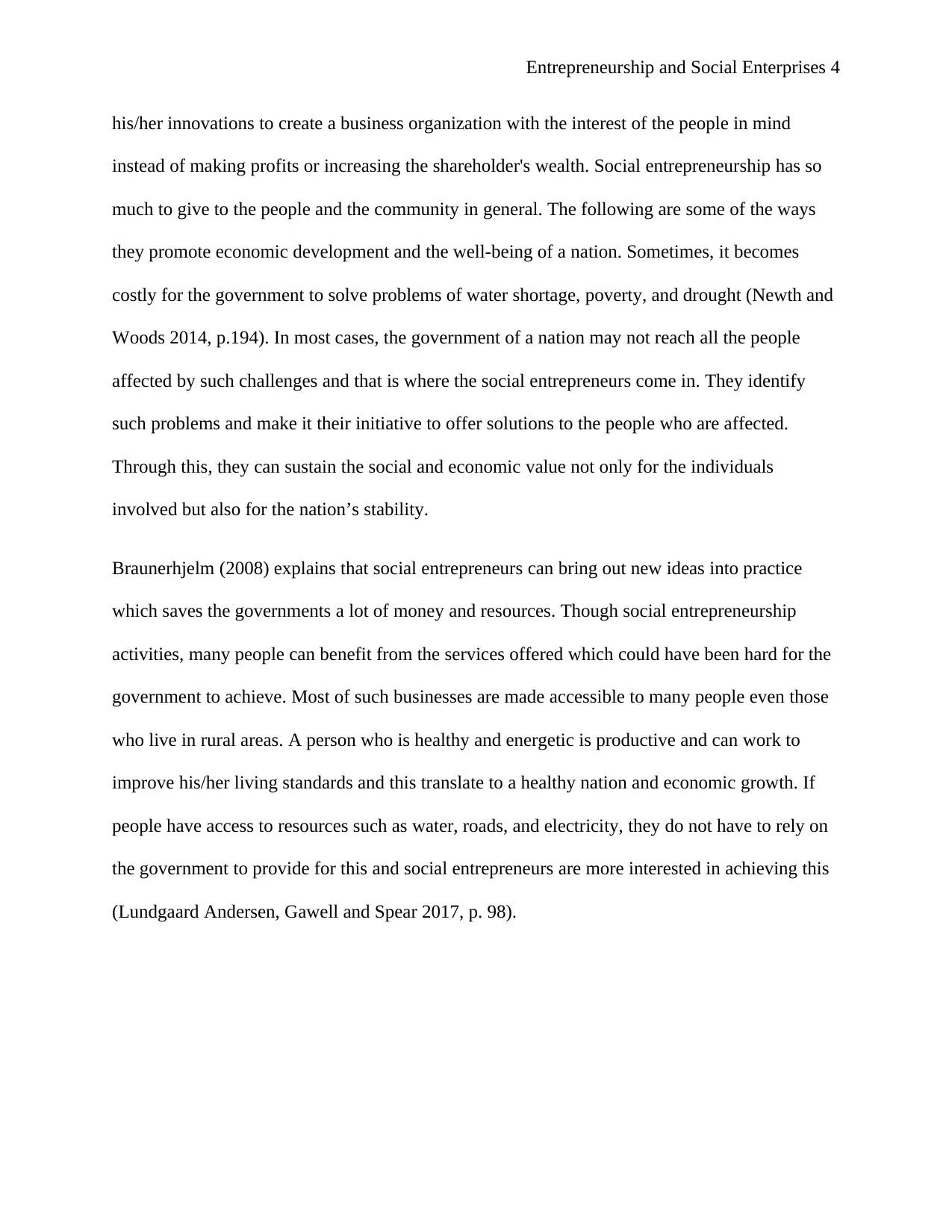
Entrepreneurship and Social Enterprises 4
his/her innovations to create a business organization with the interest of the people in mind
instead of making profits or increasing the shareholder's wealth. Social entrepreneurship has so
much to give to the people and the community in general. The following are some of the ways
they promote economic development and the well-being of a nation. Sometimes, it becomes
costly for the government to solve problems of water shortage, poverty, and drought (Newth and
Woods 2014, p.194). In most cases, the government of a nation may not reach all the people
affected by such challenges and that is where the social entrepreneurs come in. They identify
such problems and make it their initiative to offer solutions to the people who are affected.
Through this, they can sustain the social and economic value not only for the individuals
involved but also for the nation’s stability.
Braunerhjelm (2008) explains that social entrepreneurs can bring out new ideas into practice
which saves the governments a lot of money and resources. Though social entrepreneurship
activities, many people can benefit from the services offered which could have been hard for the
government to achieve. Most of such businesses are made accessible to many people even those
who live in rural areas. A person who is healthy and energetic is productive and can work to
improve his/her living standards and this translate to a healthy nation and economic growth. If
people have access to resources such as water, roads, and electricity, they do not have to rely on
the government to provide for this and social entrepreneurs are more interested in achieving this
(Lundgaard Andersen, Gawell and Spear 2017, p. 98).
his/her innovations to create a business organization with the interest of the people in mind
instead of making profits or increasing the shareholder's wealth. Social entrepreneurship has so
much to give to the people and the community in general. The following are some of the ways
they promote economic development and the well-being of a nation. Sometimes, it becomes
costly for the government to solve problems of water shortage, poverty, and drought (Newth and
Woods 2014, p.194). In most cases, the government of a nation may not reach all the people
affected by such challenges and that is where the social entrepreneurs come in. They identify
such problems and make it their initiative to offer solutions to the people who are affected.
Through this, they can sustain the social and economic value not only for the individuals
involved but also for the nation’s stability.
Braunerhjelm (2008) explains that social entrepreneurs can bring out new ideas into practice
which saves the governments a lot of money and resources. Though social entrepreneurship
activities, many people can benefit from the services offered which could have been hard for the
government to achieve. Most of such businesses are made accessible to many people even those
who live in rural areas. A person who is healthy and energetic is productive and can work to
improve his/her living standards and this translate to a healthy nation and economic growth. If
people have access to resources such as water, roads, and electricity, they do not have to rely on
the government to provide for this and social entrepreneurs are more interested in achieving this
(Lundgaard Andersen, Gawell and Spear 2017, p. 98).
Paraphrase This Document
Need a fresh take? Get an instant paraphrase of this document with our AI Paraphraser
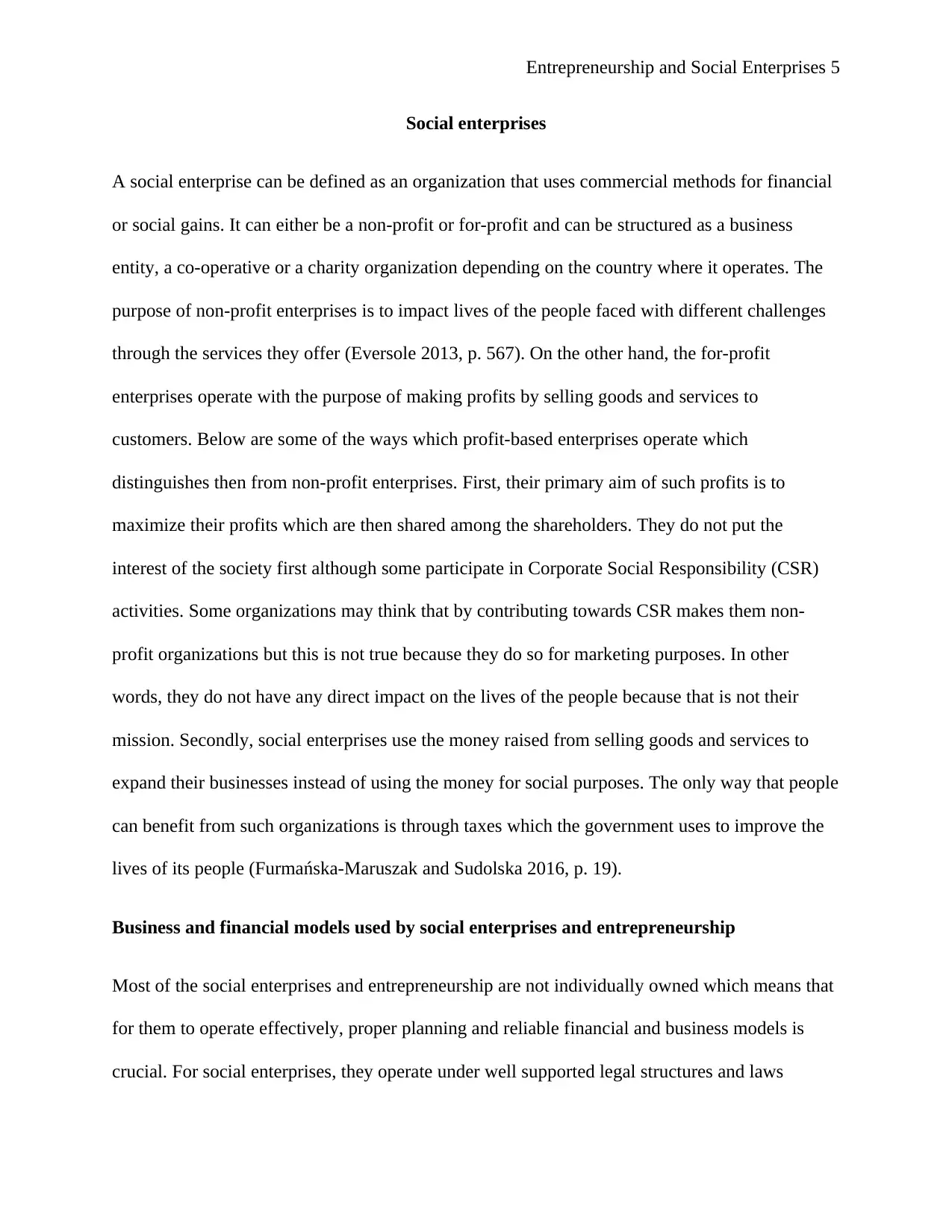
Entrepreneurship and Social Enterprises 5
Social enterprises
A social enterprise can be defined as an organization that uses commercial methods for financial
or social gains. It can either be a non-profit or for-profit and can be structured as a business
entity, a co-operative or a charity organization depending on the country where it operates. The
purpose of non-profit enterprises is to impact lives of the people faced with different challenges
through the services they offer (Eversole 2013, p. 567). On the other hand, the for-profit
enterprises operate with the purpose of making profits by selling goods and services to
customers. Below are some of the ways which profit-based enterprises operate which
distinguishes then from non-profit enterprises. First, their primary aim of such profits is to
maximize their profits which are then shared among the shareholders. They do not put the
interest of the society first although some participate in Corporate Social Responsibility (CSR)
activities. Some organizations may think that by contributing towards CSR makes them non-
profit organizations but this is not true because they do so for marketing purposes. In other
words, they do not have any direct impact on the lives of the people because that is not their
mission. Secondly, social enterprises use the money raised from selling goods and services to
expand their businesses instead of using the money for social purposes. The only way that people
can benefit from such organizations is through taxes which the government uses to improve the
lives of its people (Furmańska-Maruszak and Sudolska 2016, p. 19).
Business and financial models used by social enterprises and entrepreneurship
Most of the social enterprises and entrepreneurship are not individually owned which means that
for them to operate effectively, proper planning and reliable financial and business models is
crucial. For social enterprises, they operate under well supported legal structures and laws
Social enterprises
A social enterprise can be defined as an organization that uses commercial methods for financial
or social gains. It can either be a non-profit or for-profit and can be structured as a business
entity, a co-operative or a charity organization depending on the country where it operates. The
purpose of non-profit enterprises is to impact lives of the people faced with different challenges
through the services they offer (Eversole 2013, p. 567). On the other hand, the for-profit
enterprises operate with the purpose of making profits by selling goods and services to
customers. Below are some of the ways which profit-based enterprises operate which
distinguishes then from non-profit enterprises. First, their primary aim of such profits is to
maximize their profits which are then shared among the shareholders. They do not put the
interest of the society first although some participate in Corporate Social Responsibility (CSR)
activities. Some organizations may think that by contributing towards CSR makes them non-
profit organizations but this is not true because they do so for marketing purposes. In other
words, they do not have any direct impact on the lives of the people because that is not their
mission. Secondly, social enterprises use the money raised from selling goods and services to
expand their businesses instead of using the money for social purposes. The only way that people
can benefit from such organizations is through taxes which the government uses to improve the
lives of its people (Furmańska-Maruszak and Sudolska 2016, p. 19).
Business and financial models used by social enterprises and entrepreneurship
Most of the social enterprises and entrepreneurship are not individually owned which means that
for them to operate effectively, proper planning and reliable financial and business models is
crucial. For social enterprises, they operate under well supported legal structures and laws
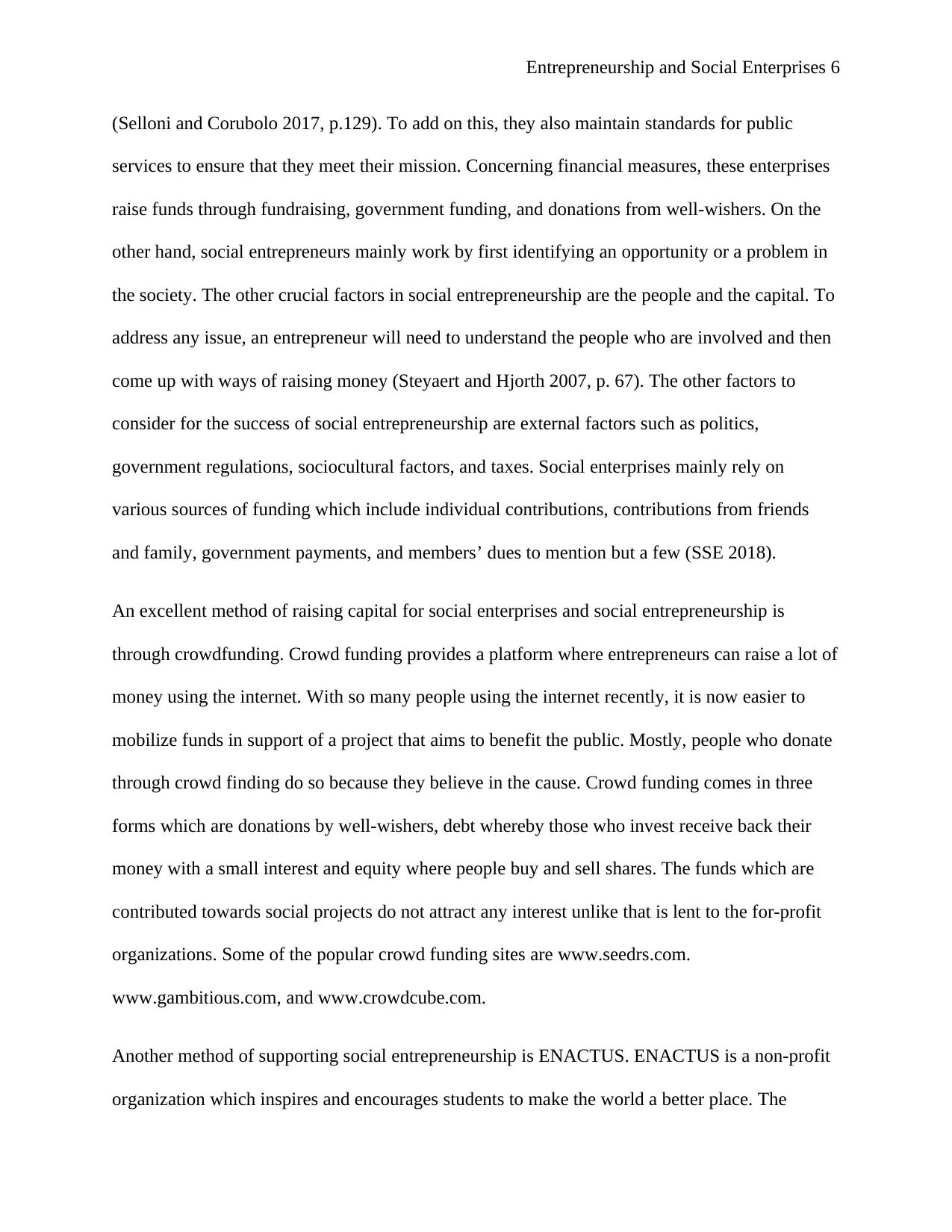
Entrepreneurship and Social Enterprises 6
(Selloni and Corubolo 2017, p.129). To add on this, they also maintain standards for public
services to ensure that they meet their mission. Concerning financial measures, these enterprises
raise funds through fundraising, government funding, and donations from well-wishers. On the
other hand, social entrepreneurs mainly work by first identifying an opportunity or a problem in
the society. The other crucial factors in social entrepreneurship are the people and the capital. To
address any issue, an entrepreneur will need to understand the people who are involved and then
come up with ways of raising money (Steyaert and Hjorth 2007, p. 67). The other factors to
consider for the success of social entrepreneurship are external factors such as politics,
government regulations, sociocultural factors, and taxes. Social enterprises mainly rely on
various sources of funding which include individual contributions, contributions from friends
and family, government payments, and members’ dues to mention but a few (SSE 2018).
An excellent method of raising capital for social enterprises and social entrepreneurship is
through crowdfunding. Crowd funding provides a platform where entrepreneurs can raise a lot of
money using the internet. With so many people using the internet recently, it is now easier to
mobilize funds in support of a project that aims to benefit the public. Mostly, people who donate
through crowd finding do so because they believe in the cause. Crowd funding comes in three
forms which are donations by well-wishers, debt whereby those who invest receive back their
money with a small interest and equity where people buy and sell shares. The funds which are
contributed towards social projects do not attract any interest unlike that is lent to the for-profit
organizations. Some of the popular crowd funding sites are www.seedrs.com.
www.gambitious.com, and www.crowdcube.com.
Another method of supporting social entrepreneurship is ENACTUS. ENACTUS is a non-profit
organization which inspires and encourages students to make the world a better place. The
(Selloni and Corubolo 2017, p.129). To add on this, they also maintain standards for public
services to ensure that they meet their mission. Concerning financial measures, these enterprises
raise funds through fundraising, government funding, and donations from well-wishers. On the
other hand, social entrepreneurs mainly work by first identifying an opportunity or a problem in
the society. The other crucial factors in social entrepreneurship are the people and the capital. To
address any issue, an entrepreneur will need to understand the people who are involved and then
come up with ways of raising money (Steyaert and Hjorth 2007, p. 67). The other factors to
consider for the success of social entrepreneurship are external factors such as politics,
government regulations, sociocultural factors, and taxes. Social enterprises mainly rely on
various sources of funding which include individual contributions, contributions from friends
and family, government payments, and members’ dues to mention but a few (SSE 2018).
An excellent method of raising capital for social enterprises and social entrepreneurship is
through crowdfunding. Crowd funding provides a platform where entrepreneurs can raise a lot of
money using the internet. With so many people using the internet recently, it is now easier to
mobilize funds in support of a project that aims to benefit the public. Mostly, people who donate
through crowd finding do so because they believe in the cause. Crowd funding comes in three
forms which are donations by well-wishers, debt whereby those who invest receive back their
money with a small interest and equity where people buy and sell shares. The funds which are
contributed towards social projects do not attract any interest unlike that is lent to the for-profit
organizations. Some of the popular crowd funding sites are www.seedrs.com.
www.gambitious.com, and www.crowdcube.com.
Another method of supporting social entrepreneurship is ENACTUS. ENACTUS is a non-profit
organization which inspires and encourages students to make the world a better place. The
⊘ This is a preview!⊘
Do you want full access?
Subscribe today to unlock all pages.

Trusted by 1+ million students worldwide

Entrepreneurship and Social Enterprises 7
organization gives students with outstanding skills an opportunity to come up with
entrepreneurship projects which will benefit those who are less privileged and the whole society
(Enactus, 2018). Through guidance from teachers and business experts, students are expected to
participate in a competition to showcase how their projects have impacted lives. The mission of
ENACTUS is to change the lives of many people as possible so as to improve the world. With
the hard economic times that the world is experiencing, ENACTUS aims to create young
entrepreneurs who will be able to solve these problems in the next generation (DEL GIUDICE
2016, p 213).
Conclusion
To sum it all, understanding the role of these organizations will shed light on why people need to
come together and find a solution to the challenges that are facing the world today. Although
there are so many non-profit entrepreneurship and enterprises today, the issue of solving the
economic problems is far from being achieved. It requires the support from individuals who are
well of and countries which are wealthy to contribute towards such courses to changes the lives
who are suffering to make the world a better place for everyone.
organization gives students with outstanding skills an opportunity to come up with
entrepreneurship projects which will benefit those who are less privileged and the whole society
(Enactus, 2018). Through guidance from teachers and business experts, students are expected to
participate in a competition to showcase how their projects have impacted lives. The mission of
ENACTUS is to change the lives of many people as possible so as to improve the world. With
the hard economic times that the world is experiencing, ENACTUS aims to create young
entrepreneurs who will be able to solve these problems in the next generation (DEL GIUDICE
2016, p 213).
Conclusion
To sum it all, understanding the role of these organizations will shed light on why people need to
come together and find a solution to the challenges that are facing the world today. Although
there are so many non-profit entrepreneurship and enterprises today, the issue of solving the
economic problems is far from being achieved. It requires the support from individuals who are
well of and countries which are wealthy to contribute towards such courses to changes the lives
who are suffering to make the world a better place for everyone.
Paraphrase This Document
Need a fresh take? Get an instant paraphrase of this document with our AI Paraphraser
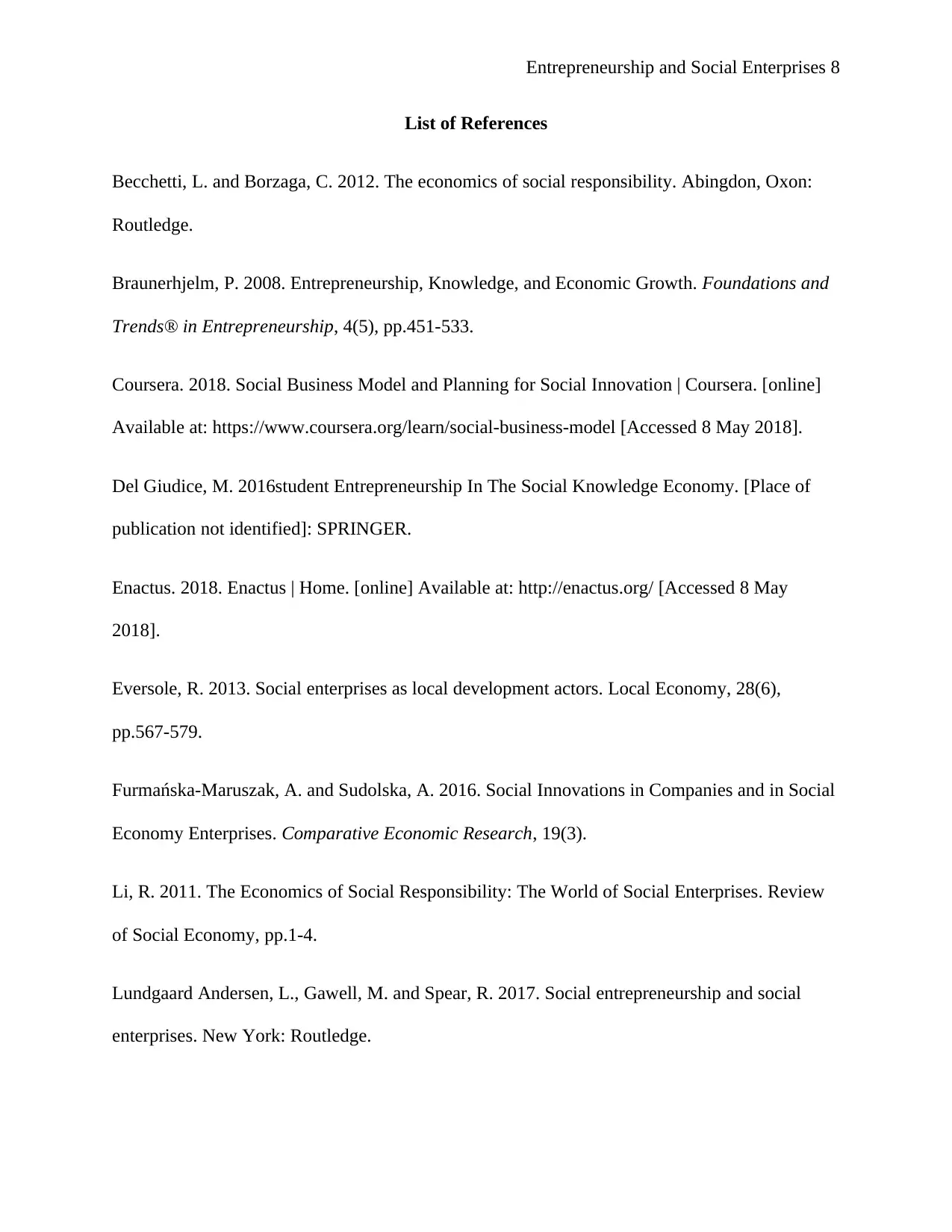
Entrepreneurship and Social Enterprises 8
List of References
Becchetti, L. and Borzaga, C. 2012. The economics of social responsibility. Abingdon, Oxon:
Routledge.
Braunerhjelm, P. 2008. Entrepreneurship, Knowledge, and Economic Growth. Foundations and
Trends® in Entrepreneurship, 4(5), pp.451-533.
Coursera. 2018. Social Business Model and Planning for Social Innovation | Coursera. [online]
Available at: https://www.coursera.org/learn/social-business-model [Accessed 8 May 2018].
Del Giudice, M. 2016student Entrepreneurship In The Social Knowledge Economy. [Place of
publication not identified]: SPRINGER.
Enactus. 2018. Enactus | Home. [online] Available at: http://enactus.org/ [Accessed 8 May
2018].
Eversole, R. 2013. Social enterprises as local development actors. Local Economy, 28(6),
pp.567-579.
Furmańska-Maruszak, A. and Sudolska, A. 2016. Social Innovations in Companies and in Social
Economy Enterprises. Comparative Economic Research, 19(3).
Li, R. 2011. The Economics of Social Responsibility: The World of Social Enterprises. Review
of Social Economy, pp.1-4.
Lundgaard Andersen, L., Gawell, M. and Spear, R. 2017. Social entrepreneurship and social
enterprises. New York: Routledge.
List of References
Becchetti, L. and Borzaga, C. 2012. The economics of social responsibility. Abingdon, Oxon:
Routledge.
Braunerhjelm, P. 2008. Entrepreneurship, Knowledge, and Economic Growth. Foundations and
Trends® in Entrepreneurship, 4(5), pp.451-533.
Coursera. 2018. Social Business Model and Planning for Social Innovation | Coursera. [online]
Available at: https://www.coursera.org/learn/social-business-model [Accessed 8 May 2018].
Del Giudice, M. 2016student Entrepreneurship In The Social Knowledge Economy. [Place of
publication not identified]: SPRINGER.
Enactus. 2018. Enactus | Home. [online] Available at: http://enactus.org/ [Accessed 8 May
2018].
Eversole, R. 2013. Social enterprises as local development actors. Local Economy, 28(6),
pp.567-579.
Furmańska-Maruszak, A. and Sudolska, A. 2016. Social Innovations in Companies and in Social
Economy Enterprises. Comparative Economic Research, 19(3).
Li, R. 2011. The Economics of Social Responsibility: The World of Social Enterprises. Review
of Social Economy, pp.1-4.
Lundgaard Andersen, L., Gawell, M. and Spear, R. 2017. Social entrepreneurship and social
enterprises. New York: Routledge.
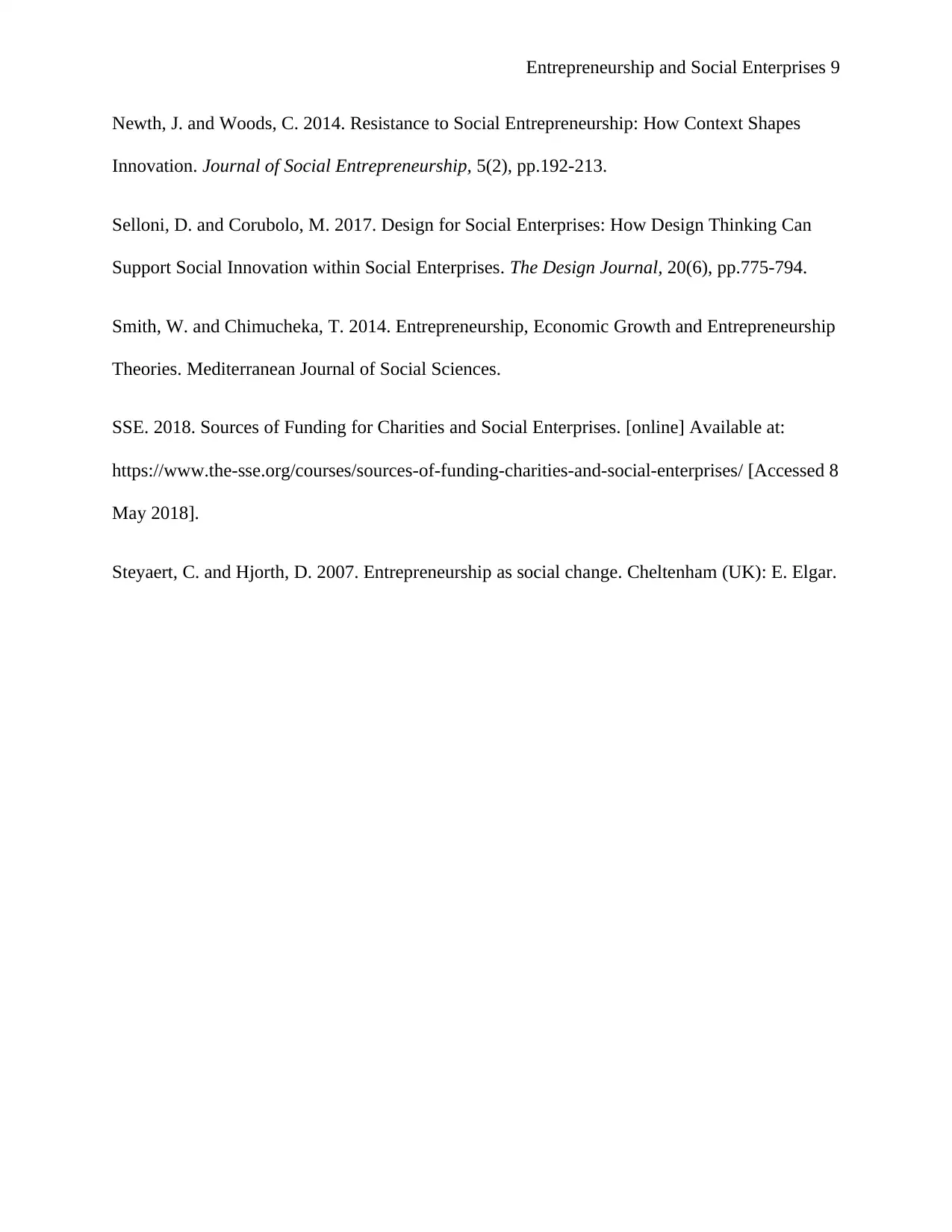
Entrepreneurship and Social Enterprises 9
Newth, J. and Woods, C. 2014. Resistance to Social Entrepreneurship: How Context Shapes
Innovation. Journal of Social Entrepreneurship, 5(2), pp.192-213.
Selloni, D. and Corubolo, M. 2017. Design for Social Enterprises: How Design Thinking Can
Support Social Innovation within Social Enterprises. The Design Journal, 20(6), pp.775-794.
Smith, W. and Chimucheka, T. 2014. Entrepreneurship, Economic Growth and Entrepreneurship
Theories. Mediterranean Journal of Social Sciences.
SSE. 2018. Sources of Funding for Charities and Social Enterprises. [online] Available at:
https://www.the-sse.org/courses/sources-of-funding-charities-and-social-enterprises/ [Accessed 8
May 2018].
Steyaert, C. and Hjorth, D. 2007. Entrepreneurship as social change. Cheltenham (UK): E. Elgar.
Newth, J. and Woods, C. 2014. Resistance to Social Entrepreneurship: How Context Shapes
Innovation. Journal of Social Entrepreneurship, 5(2), pp.192-213.
Selloni, D. and Corubolo, M. 2017. Design for Social Enterprises: How Design Thinking Can
Support Social Innovation within Social Enterprises. The Design Journal, 20(6), pp.775-794.
Smith, W. and Chimucheka, T. 2014. Entrepreneurship, Economic Growth and Entrepreneurship
Theories. Mediterranean Journal of Social Sciences.
SSE. 2018. Sources of Funding for Charities and Social Enterprises. [online] Available at:
https://www.the-sse.org/courses/sources-of-funding-charities-and-social-enterprises/ [Accessed 8
May 2018].
Steyaert, C. and Hjorth, D. 2007. Entrepreneurship as social change. Cheltenham (UK): E. Elgar.
⊘ This is a preview!⊘
Do you want full access?
Subscribe today to unlock all pages.

Trusted by 1+ million students worldwide
1 out of 9
Related Documents
Your All-in-One AI-Powered Toolkit for Academic Success.
+13062052269
info@desklib.com
Available 24*7 on WhatsApp / Email
![[object Object]](/_next/static/media/star-bottom.7253800d.svg)
Unlock your academic potential
Copyright © 2020–2025 A2Z Services. All Rights Reserved. Developed and managed by ZUCOL.





